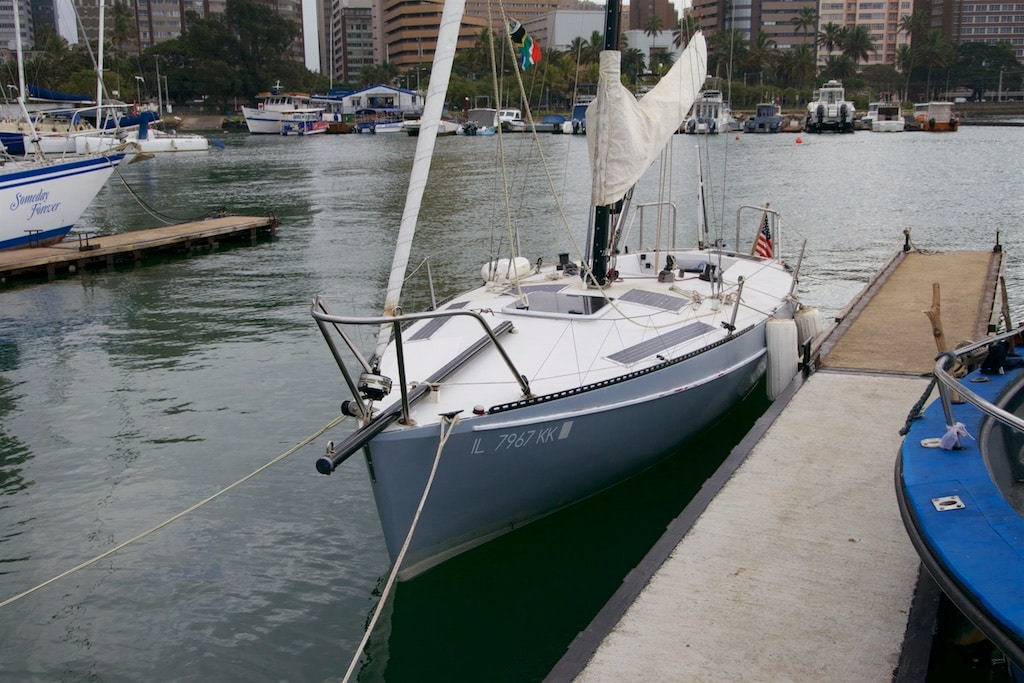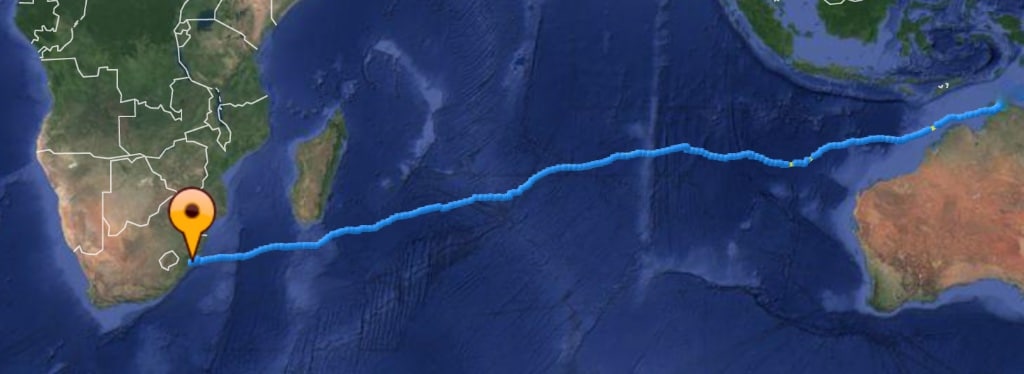
At 0500 Monday, August 22, our 53rd day at sea since leaving Darwin, Australia, the wind died, and Gannet, my Moore 24, and I were becalmed 10 miles from Durban Harbor, South Africa. Confident that the remainder of the 6,000-mile passage would be over in a few hours, I took advantage of the smooth conditions to fit the outboard bracket and electric Torqeedo onto the stern. The Torqeedo had not been used in months, not since I’d powered the last half-mile to the marina in Bundaberg, Australia. I was pleased when it started at the first push of a button. Then I removed the tiller arm and tilted the Torqeedo from the water. It has a limited range, and I would use it only after entering the port.
A few minutes later the wind, which had been light and behind us, returned with a rush, but from directly ahead. I raised a triple-reefed main and partially unfurled the jib.
The wind continued to build and build. Had I not so wanted to get in, I would have stopped sailing by 0600. But I did and kept on. Gannet was heeled 40 degrees, thrashing through and under water, the lee rail buried. Activity below was impossible. One of the rules on Gannet is the same as in boxing: Protect yourself at all times. Trying to heat water for coffee, momentarily I didn’t, and was thrown across the cabin. That wasn’t far, of course, but I lost some skin and got a good-size lump on my elbow. I drank the coffee with room-temperature water and ate a protein bar for breakfast.
With the wind coming partially over the point of land to the south, I thought it possible that the sea would be smoother closer to the coast. I was wrong. The wind there was as strong and the waves steeper. I threaded my way through a half-dozen anchored ships awaiting entrance to the harbor, until I ran out of room and a mile offshore tried to come about. Despite moving at speed, Gannet didn’t have the weight to do it. The wind stopped and shook the boat like a dog shakes a bone. I had to do what I didn’t want to, and jibed. The power of the boom going over was immense. Gannet went to almost 90 degrees, but Moore 24s are self-correcting boats. They seem to want to do the right thing, and as I eased the sheet, she came up. Some. As I steered back past the anchored ships, one of them gave a blast on her horn that I decided to interpret as applause. To the south I could see the breakwaters at Durban, 7 miles away.

Wave after wave swept over Gannet and me. While being flailed in the failed attempt to tack, the jib sheets had tied themselves in a Gordian knot. Once clear of the ships, I tied down the tiller and lowered and subdued the mainsail, then went forward to untangle the jib sheets so I could furl the headsail.
All brutal and dangerous.
Finally, under bare pole and being pushed north, I called on the handheld VHF to the anchored ships, asking for wind speed and forecast. One of them answered, reporting a wind speed of 45 knots, forecast to go to 50 with 20-foot waves and easing in 24 hours. Gannet’s cabin was as wet as it has ever been, but she felt safer and much less likely to be rolled. She had taken a beating. We both had.
I don’t think the waves ever reached 20 feet — perhaps 12 to 14 — but I have always preferred to err on the low side rather than high. Whatever their height, they were steep walls of seething water and big enough.
After an unrelenting afternoon and night, the wind began to drop at 1000 Tuesday, almost as abruptly as it rose. Even after all these years, I am sometimes amazed by how quickly waves decrease with the wind. By 1300, Gannet was headed back toward Durban, now 40 miles away, making 3 and 4 knots under full sail across a mildly undulating sea on a sunny afternoon. Two whales spouted a few lengths away. Albatrosses glided above us. We entered the harbor late the next morning and tied to the international jetty at noon.
This 6,000-mile passage had been difficult and sometimes tested my limits, first with too little wind. A week out of Darwin, we’d been becalmed for almost 24 hours on a glassy sea, and Gannet had her slowest day’s run ever, of only 28 miles. I went overboard for a swim, startling a fish that seemed to be living beneath us.
Then we’d had two weeks of too much wind: 25-plus knots going to gale force twice. This was complicated by tillerpilot failure. I probably did 5,000 of the 6,000 miles using sheet-to-tiller steering. In strong wind, this approach can result in accidental jibes. Twice I had to lie ahull because the risk of being rolled was too great. And Gannet’s interior was entirely wet, as was I. Every surface was covered in slime and mold. My sleeping bag was intolerably sodden, so I slept in wet foul-weather gear beneath a foil survival blanket. Finally that ended, and we again had mostly too-light wind.
On a moderate day, with only 6-foot waves, one of the waves broke and caught us just right, rolling the masthead into the water. I know it went in because afterward the masthead Windex was hanging off the side, and the masthead Raymarine wind unit was gone. I somehow don’t think this will be covered under warranty. (Gannet is the fourth boat whose masthead I have put in the water. This is a club you probably don’t want to join.)
Gannet has covered more than 9,000 miles since we sailed from Opua, New Zealand, less than four months ago. Despite being driven and tossed on the deep blue sea, she hasn’t suffered any structural damage that I can see.
We have done what we planned to do this year. We are both going to rest.
Six-time solo circumnavigator and writer Webb Chiles began his most recent great circle aboard Gannet in San Diego.








